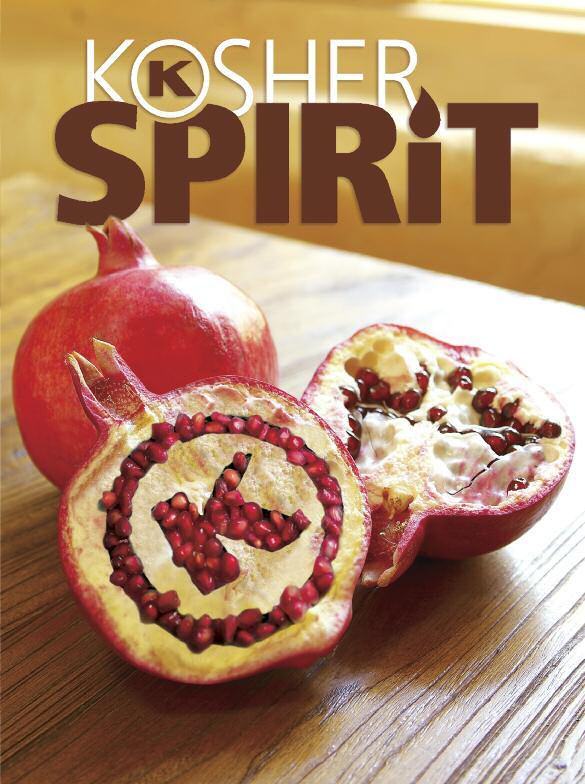
vba vcuy veu,nu
2008 hra, yWxa,
ELUL/TISHREI
3 4 6 10 13 14 19 20 22 24 26 27
SHARE YOUR SPIRIT QUESTIONS FOR THE ~ GOING WITH THE GRAIN
By Rabbi Yosef D Chanowitz
BAMBOO SCHACH
By Rabbi Don Yoel Levy
THE POWER OF POMEGRANATES LIKE THE BREATH OF APPLES...
By Rabbi Zushe Yosef Blech
5 TIPS TO AVOID IDENTITY THEFT
TISHREI RECIPES
POP-UP SUKKAH
By Rabbi Chaim Fogelman
WHO’S BEHIND THE
Inter view with Rabbi Cohn
CHASSIDIC INSIGHTS SIMCHAS BEIS HASHOEVA

Compiled by Dina Fraenkel
ODDS & ENDS
EDITOR-IN-CHIEF:
Rabbi Chaim Fogelman
EDITOR:
Dovi Scheiner
ASSOCIATE EDITOR:
Dina Fraenkel
DESIGN:
www.SpotlightDesign.com
CONTRIBUTING WRITER:
Rabbi Zushe Yosef Blech
Author
Food Production”
Dear Reader,
There’s something special about a new year, a fresh start – like writing on the first page of a new notebook, or the first day of school, starting new and forgetting the old This newness holds true to every New Year, but how much more so this year
This is a Hakhel year, where, in the time of the Beis HaMikdash, we would gather together during Sukkos to hear the king read from the Torah and give us encouragement for the years ahead Some people still have a custom to gather together in a year of hakhel to share words of encouragement
This year, the first year after shmitta, we begin the seven-year-cycle again. One would think that we only look ahead, never looking back. However, in the kashrus industry and for the kashrus-minded consumer, the effects of shmitta still play a big part in what lies ahead. Like rollover minutes, produce and products with ingredients that were grown or harvested during shmitta roll over into the months and even years ahead and must be carefully monitored Not only do we have to investigate how they were produced, but when they were planted and harvested Were they processed and handled in accordance with the laws of shmitta?
A mere two weeks after the end of the shmitta year we are already faced with a question Can we use an esrog grown in Israel during the shmitta year? Check out page 4 for an overview of the relevant facts and methods for using a shmitta esrog At the ~, much effort is expended to ensure that ingredients coming from Israel are free from shmitta restrictions
Another area where one must closely monitor the planting and harvesting of produce is Yoshon and Chodosh Beginning on page 6, in his article “Going With the Grain: Chodosh in the Diaspora, ” Rabbi Chanowitz takes you through the challenges and customs surrounding the interesting mitzvah of Yoshon
Speaking of customs, Rabbi Zushe Blech, a guest contributor, enlightens us about the unique custom of dipping an apple into honey, as opposed to any other fruit. Later, read why we choose a pomegranate for our new fruit and what is so special about the pouring of water on the Mizb’each as opposed to wine. In this issue we’ve got you covered from your first sit-down dinner of the year, to a bite on the run in a Pop-up Sukkah
K’siva v’chasima tovah, l’shana tovah u’mesukah May you be inscribed in the Book of Life for a happy and sweet new year
Rabbi Chaim Fogelman
Editor-in-Chief
NEW TO THE ~: We would like to welcome Rabbi Elisha Rubin to the staff of the ~ Rabbi Rubin joins us as a Rabbinic Coordinator and we are excited to have him as a part of the ~ family
CORRECTION: In the Pesach issue, we wrote that Rabbi Ahron Haskel lear ned in Beis Medrash Gevoha in Lakewood, NJ He actually studied at the Beit Hamidrash Hagavo’a Lehora’a Beit David in Eretz Yisroel
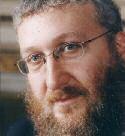
musmach
Yisroel, and has spent
years reviewing and investigating kashrus issues throughout the world His articles on kashrus
the
Second Edition
which is about to be published
of “Kosher
Rabbi Zushe Blech is a
of Yeshivas Ner
over 25
have been published in many venues and is
author of Kosher Food Production, the
of
~
Share Your Spir it
Readers share their thoughts about the last issue...*
Dear Kosher Spir it,
Ijust wanted to give you a Yasher Koach on the very nice article you wrote about the medicines for Pesach. I hope your article will be spread and read by many people!
Chag Kosher Vesameach, Rabbi Sholem Fishbane, CRC-Chicago
Dear Kosher Spir it,
Thanks for your article, about time someone had the guts! I have my own personal experience; I had a request from a local distributor to certify a certain brand name mouthwash for Pesach I was working with the CEO, going through ingredients and “necessary changes ” Lo and behold, in “The Pesach Book” the product is listed as kosher for Passover I inquired how this is possible and was told that a secretary in the mouthwash company’s office had received a call, and based on her answers the product was endorsed.
HaRav Usher Anshel Eckstein, Vaad HaKashrus of Kehal Machzikei Hadas of Belz
Dear Kosher Spir it,
Ireceived the Kosher Spirit Pesach issue enclosed in Hamodia It was fascinating and I would love to receive future issues as well!
Kind Regards, JG
We welcome your comments, submissions and letters to the editor.
MAIL: 391 Troy Avenue Brooklyn, NY 11213
E-MAIL: editor@kosherspir it com
* Editor’s Note: Rabbi Levy’s ar ticle on Pesach Medicine Lists can be f ound on the web at www.kosherspir it.com

Dear Kosher Spir it,
Ihope this email finds you in the best of health. I wanted to put in my two cents on the article that Rabbi Levy wrote regarding Pesach medication lists I had the ze ’chus to work with Rabbi J J Hecht, ob”m, pertaining to the Pesach list for a number of years I would like to let you know what Rabbi Hecht’s opinion was. He always stressed, as Rabbi Levy has, that when you have a question you must ask both a competent doctor and rabbi. The list was just a crutch for people to look at Most people including B’nei Torah don’t understand what the kitniyos chumra was all about and they apply it to medications as well This is a great mistake It is very easy to be a chossid shoi’ta (i.e. foolishly zealous) in this case.
The other mistake people make is that they equate vitamins with medication. The fact is that vitamins are nutritional value products, which means that they are like food If you need to watch out for chometzdik food on Pesach, then vitamins fall into the same category Rabbi Hecht always said, in reference to vitamins only, “when in doubt do without.” Matzoh is the Jewish soul food and it will sustain us.
Thanks,
Bensie Chanowitz Pharmacist
www.OK.org • 3
F E E D B A C K
The ~ receives many letters/emails with kosher questions...

Dear ~
Can you outline the main issues?
The ~ responds:
Thisis a ver y complex question, with many more questions hidden below the surface. Here is a list of potential questions and possible solutions regarding an esrog grown in Eretz Yisroel dur ing a shmitta year. In light of var ying halachic opinions on this matter, we recommend that you consult your local Or thodox rabbi for a definitive answer.
1. Can you buy an esrog that was grown in Eretz Yisroel dur ing a shmitta year?
2. Can you take a shmitta esrog out of Eretz Yisroel?
3. If yes, do you have to send the esrog back to Eretz Yisroel after Sukkos?
4. Can you dispose of the esrog after Sukkos?
5. Can you eat jelly made from the esrog?
6. Is it per missible to make esrog liqueur from the esrog?
7. Does the esrog have kedushas shvi’is if it blossomed dur ing the sixth year, but was picked dur ing shmitta?
To address the questions of whether one may buy or use a “shmitta esrog” , we first need a shor t introduction regarding the general laws of shmitta
In Eretz Yisroel, dur ing the shmitta year, it is f orbidden to plant, do most f orms of “working the land” (activities done to prevent damage are generally permitted), or to do business with shmitta produce and otherwise treat them in a manner that reflects ownership
It is permitted to eat and use (in a non-destr uctive manner) fr uit that grew on its own dur ing the shmitta year.
However, according to Halacha, a shmitta fr uit cannot be taken out of Eretz Yisroel 1 Some Rabbonim give a heter to take the esrog, because it is used f or a mitzvah or because it is transpor ted by non-Jews, while others give the heter on the condition that the esrog is retur ned to Eretz Yisroel after Sukkos
We theref ore need to deal first with how we can “buy/sell” the esrog.
Methods of dealing with the “sale” of the esrog:
A. Heter Mechira
Some Rabbonim f eel that if we conditionally sell the entire land of Israel to non-Jews, then this would circumvent many of the restr ictions of shmitta T his is, in f act, the policy of the Chief Rabbinate of Israel
However, other prominent Rabbonim reject this approach f or a var iety of reasons 2 T he prevalent opinion is not to rely on this approach and even the Chief Rabbinate of Israel considers it acceptable only because of great need, and not an ideal approach. T his holds tr ue f or all shmitta produce, not just esrogim.
T he ~ does not cer tify products containing produce produced using this leniency.
B. Havla’a
T he Gemara3 says that after the year of shmitta, one should buy a lulav (a non-f ood item not subject to the laws of shmitta) and have the esrog included with no charge T his might be
4 • www.OK.org
, I’ve come across many questions regarding the use of an esrog grown in Eretz Yisroel dur ing shmitta.
the reason why traditionally the arba minim have always been sold as a set and not individually Many are hesitant to rely on this approach, because in the time of the Gemara, the relationship between the value of an esrog and lulav was such that one could conceivably include an esrog in the pr ice of a lulav Today, when the value of the esrog greatly exceeds that of the lulav, it is hard to view the esrog as being “included” in the sale of the lulav
C. Otzar Beth Din
Another approach is what is known as Otzar Beth Din As noted above, the produce of shmitta must be treated as “ownerless” and permitted f or anyone to take It is, however, permitted f or a public entity, acting in the public interest to hire workers4 to har vest the fields and make the fr uit available to the public T hey may then collect a f ee to recoup their costs
T his is the most common method used today to obtain an esrog in a shmitta year Obviously consumers should look f or the cer tification that their esrog is being “sold” through an Otzar Beth Din Typically an Otzar Beth Din set-up will result in esrogim being sold f or a [relatively] fixed pr ice and f or less than in a typical year.
Using the Esrog
If an esrog has been procured and handled by one of the methods mentioned above, then it is acceptable f or use If however, one suspects that the esrog was sold or tended to in an unacceptable manner then there is the possibility that the esrog is not kosher to eat. It is a dispute among poskim whether an esrog that is not kosher to eat is kosher to shake. Rabbi Moshe Feinstein zt”l5 (among others) r ules that, in f act, such an esrog is kosher to shake.

T here are some people who remain uncomf or table using an esrog grown in Eretz Yisroel f or Sukkos f ollowing shmitta (like this year), even if the esrog was handled properly, and theref ore buy esrogim from Calif or nia, Ar izona, Morocco, Mexico, Italy, or other locations that are not subject to the laws of shmitta. Many people pref er to buy a Yanover esrog from Calabr ia, Italy ever y year, because there is a tradition that when Hashem told Moshe, “and you shall take f or you a pr i eitz hadar, ”
messengers were sent on a cloud to br ing esrogim from Calabr ia In addition, there is a mesorah (transmission of tradition) that all Yanover esrogim are from pure esrog trees (and not grafted with other citr us trees)
After Sukkos
A shmitta fr uit may not be r uined or disposed of . However, the fr uit may be eaten6 in the manner it is normally eaten or left to rot on its own. T he best solution is to allow the esrog to dr y up or rot immediately after Sukkos and then dispose of it. ~
1 Rambam 5-13
2 Mostly due to questions regarding the legitimacy and appropr iateness of the sale of Eretz Yisroel to a non-Jew
3 Succah 39
4 As a practical matter, today the “workers” will typically be the field’s owners T hey know the fields, need the money, and have time on their hands
5 O”C 1-186
6 According to some opinions, shmitta fr uit may not be eaten outside of Eretz Yisroel
www.OK.org • 5
To submit your questions to the ~, email: info@ok.org
Th i s y e a r t h e r e i s a
c r i s i s f o r t h o s e
w h o a r e p a r t i c u l a r
t o o b s e r v e t h e m i t z v a h o f Yoshon. The price of wheat
r o s e t o $ 1 2 a b u s h e l (about three times higher t h a n r e c e n t y e a r s ) a n d a t one point hit a record high of $25 a bushel (six times the usual price)!
The sharp increase may be a result of the use of several grains for biofuel, as well as a drought in Australia and a sub-par rice crop in China In addition, the demand for wheat abroad triggered an ever-increasing percentage of exported crops, which caused the U S wheat surplus to be diminished to the second lowest level in U S history This raised the price of wheat The small amount of surplus wheat needs to be mixed with the new spring flour (as explained later in the article) so the wheat flour sold to the distributors will have some consistency

As many people struggle with the

 By Rabbi Yosef D. Chanowitz
By Rabbi Yosef D. Chanowitz
price of wheat, we will examine the source for the prohibition of eating Chodosh, and the possible requirement of its practice in the Diaspora
The source of the prohibition of eating Chodosh originates in Parshas Emor (23:14):
grain belongs to Hashem Only after the Korban Omer is offered can we enjoy the grain ourselves This is particularly illustrated through grain, which is a staple food
“You should not eat bread, parched grain flour or parched kernels [from the new crop] until this very day, until you bring the [Omer] offering for your G-d. [This is] an eternal statute throughout your generations, in all the places that you live.”
The Torah prohibits eating from the grain harvest that has taken root after the Korban Omer (an offering of barley) was offered in the Beis Hamikdash. One must refrain from using it until the Omer of the subsequent year is offered, on the sixteenth day of Nissan In addition we cannot harvest the grain until after the Korban Omer is given 1
The Chinuch2 explains that this mitzvah serves as a reminder that all the food we have is provided by Hashem, therefore, the first portion of
The laws of Chodosh apply to the five grains: wheat, barley, oat, rye, and spelt They are considered Chodosh unless they took root prior to the sixteenth day of Nissan [There is a halachic dispute whether they must be planted three days before the Omer or fourteen days] 3 However, the laws of Chodosh do not apply to any other grains, such as corn, rice, buckwheat, soy, potato and tapioca.
In the times of the Beis Hamikdash, the local community in Yerushalayim would wait until the morning of the sixteenth of Nissan when the Omer was offered. The rest of the population in Israel would wait until noon, to be sure that the Korban Omer was offered Since the destruction of the Beis Hamikdash, there is no Korban Omer Therefore, Rabbi Yochanan Ben Zakai instituted that the community should wait until the end of the sixteenth of Nissan to eat the new grain Furthermore, here in the Dias-
GOING WITH THE GRAIN
6 • www.OK.org
oI É Hv ¿ o † m Î † g sg U ½ k ‰ ft œ , t É O k ¤ n § rf ± u h Î k ¨ e± u Ï o ¤ j Ï † k ± u ,Eª j o · fhv œ O ¡ t i¼ C § re , ¤ t o º † f £ th É c £ v sg v º ® Zv :o œ fh, œ c § J œ n k ¼ f ‰ C o º † fh, É rs ‰ k ¿ o Š kIg
שדח-ןשי
pora, where we keep a second day of Pesach (since we are not sure which is the real day of Pesach [Sefeika D’yoma]), one should wait another day until the end of the seventeenth of Nissan to eat the grain 4

DIASPORA: THE DISCUSSION5
Presently, in the Jewish community, the mitzvah of Yoshon and the prohibition of eating Chodosh are very interesting phenomena. On one hand it seems quite evident that there is a mitzvah of not eating Chodosh On the other hand, we find that it has not been accepted in the diaspora as a regular mitzvah (like krias shema or tefillin) and is not observed by the entire Jewish community
Even more so, entire communities that go out of their way to be extra careful in the observance of every mitzvah, are not particular about eating Yoshon Why is it that some forbid Chodosh entirely, while others do not consider it a problem?
Why was it so hard for the Poskim throughout the generations to
enforce the mitzvah of Yoshon and why couldn’t they make a Yoshon list for their congregants to follow?
Today, verifying that a product is Yoshon is a very complex task. In earlier generations, before the information age, it was even harder, if not impossible, to verify Yoshon status, so it is easy to understand why the Rabbonim and Poskim never made a Yoshon list for their congregants Secondly, there are many reasons why Yoshon may not apply in the Diaspora
In 1980, the Lubavitcher Rebbe mentioned: “If one goes out into the streets of Brooklyn, New York, or even in Williamsburg, one will not find a single individual who is careful not to eat Chodosh If you will indeed find such a Jew, blessing should be bestowed upon him, but I at least have not found such a Jew” (Sichos Kodesh of Acharon Shel Pesach 5740, Chapter 76).
At the time, the concept was indeed foreign to communities in the Diaspora, however, halachically, there is a very strong basis to say that the laws of Chodosh apply today as they applied in the times of the Beis
Hamikdash Most Lithuanian communities follow the Vilna Gaon, who was of the opinion that Chodosh applies Chutz L’Aretz (outside the Land of Israel), while many Chasidic communities follow the Bach’s opinion that the laws of Chodosh don’t apply outside of Israel.
Here are a number of reasons why Chodosh might not apply today:

1 We are in the Diaspora6
In the Mishna there is a discussion regarding Chodosh in outside of Israel. Rabbi Eliezer says that Chodosh applies in the Diaspora, while the Chachamim disagree and hold that Chodosh only applies in Eretz Yisroel.
The majority of the Rishonim agree with Rabbi Eliezer and forbid Chodosh in the Diaspora, however, some say that we follow the opinion of the Chachamim (which are the majority of the sages) and Chodosh is only Mi’d’rabbanon Some go even further and say that based on the Chachamim, Chodosh is allowed even Mi’d’rabbanon
2 Grain belonging to a non-Jew7
There is a dialogue in the Talmud
www.OK.org • 7
Today, ver ifying that a product is Yoshon is a ver y complex task...
regarding the grain of a non-Jew

Many hold that it cannot be used for the Omer offering in the Beis Hamikdash. The Bach derives from this that grain of a non-Jew is not included in the prohibition of Chodosh It appears from the opinion of most Rishonim that Chodosh applies to the grain of Jews and non-Jews alike. There were Poskim who defended the Bach’s approach and there were those who disagreed completely Either way, his opinion became synonymous with the Chodosh debate.
3 Today Chodosh is only a saf ek s’feika (twof old doubt)8
The Ramah defends the practice of eating Chodosh by arguing that there is a double safek regarding grain on the market Is the grain on the current market from this year (after last Pesach) [prohibited] or from last year (before last Pesach) [permitted]? Even if it is this year’s grain, did that grain take root before Pesach or after Pesach? Some disagree with the Ramah, claiming that it is one big safek, not a double safek
4. Today Chodosh is Mid’rabanan (Rabbinic prohibition)9
Chodosh may not be Mi’d’oraisa (from the Torah) for a number of reasons: a) we are in the Diaspora, b) the grain belongs to the non-Jew, and c) the Chodosh is Botul B’rov (the majority of the grain market is not Chodosh) Therefore, since we are not sure whether a particular wheat is Yoshon, we can rely on the majority and be lenient (Safek D’rabbanon Le’kula).
5. We are in a sh’as hadchak (time of need)10
Grain is essential to our diet Since we cannot survive without it, the Rabbis allowed us to be lenient regarding this mitzvah.
6 It has become an accepted minhag (practice) with a Halachic basis, so we f ollow the minhag11
Although the Halacha, according to some, seems to indicate otherwise one should follow the accepted practice
7. Storage problems
Yoshon grain is often heavily infested with insects during storage
AGRICULTURAL GRAIN FACTS12
To further understand the complexity of Yoshon, one must look deeper into the nature of today’s grain market
SPRING & WINTER WHEAT CROPS
Wheat is second only to corn (maize) as the most frequently grown crop in the world It is an essential food which is used to make bread, pastry, alcohol and bio-fuel The United States is one of the largest producers of wheat, along with China, India, Russia, Canada and Australia Since the U S has such a large surplus of wheat, it exports a large percentage of the crop and has no need to import wheat from other countries (with the exception of Canada, depending on quality and pricing). The self-sufficiency of the U.S. wheat market enables us to assess the Chodosh issue based on the U.S. alone, without concern that Chodosh crops will come in from other countries.13 In the U.S., there are two general crops of wheat: spring wheat and winter wheat, which differ in climate, maintenance and quality.
Generally speaking, spring wheat is Chodosh as it is usually planted after Pesach and harvested between August and September. Since spring wheat starts growing around Pesach, some plants actually take root prior to Pesach (16th of Nissan), especially when
Pesach falls late in April This creates a Safek since it is impossible to be sure that spring wheat is Chodosh Some Poskim say that this is a Safek Mid’rabanan (as we explained earlier) so one can be lenient in this case
Most farmers, when left with a choice to plant their field with spring or winter wheat, grow their crop in the winter for the following reasons: a) there is greater insect infestation during the summer, b) most fields need irrigation in the spring since the land is dry and precipitation is low, and c) soft winter wheat is easier to grow and therefore less processing is needed, which makes the product more profitable As a result, most wheat grown in the U S is winter wheat, which is automatically Yoshon.
BARLEY AND BARLEY MALT
Barley is a very popular grain which is used mostly as feed for livestock, but is also used in malt and beer Barley is mostly grown in Eastern Europe, Turkey and Canada and is also grown in the U S in a smaller quantity It is generally grown in the spring and may be Chodosh, because barley is much more climate sensitive than wheat and does not grow well in the winter except in locations with a very mild winter
The new crop arrives on the market from October to December Beer and malt (which is used as a processing agent in many flour mixes and as a flavor) produced from barley would arrive on the market closer to December Incidentally, some Poskim are lenient regarding Yoshon and beer, because beer would not be included in “Lechem” that the Torah describes This reasoning would enable the use of vodka and whiskey, as well Other Poskim disagree with this premise and don’t differentiate between beer and barley or vodka and wheat.14
8 • www.OK.org
OATS
Oats are grown in countries like Russia, Canada, Europe and the U S and are used to feed livestock as well as for human consumption; as oat flour, rolled oats, granola, and occasionally beer Oats have greater tolerance of rainy, cool weather than other grains and are easily grown in northwest Europe where the climate is damp and wet the entire summer
Oats can be planted in either the autumn or the spring, so they may be Chodosh The first spring crop can arrive in the market as early as July or August However, most oats in the United States arrive from Canada in September or October
RYE AND SPELT
Rye is mostly grown in Europe and in small quantities in Canada and the U.S. and is used in rye breads, whisky and beer, or as alternative medicine. In the U.S., rye and spelt are grown in the winter so there is no Chodosh problem. However, in Canada this may not be the case.
PRACTICALLY SPEAKING
Many products may not seem to be a Chodosh issue on their own, but have an ingredient that may be Chodosh As the examples in the sidebar illustrate, there are many complications in implementing a Yoshon diet For a company to commit to be a Yoshon facility, the kosher certification agency must be very aware of all these complexities and ensure that even the most minor ingredients are Yoshon 15
In the past it was easier for large suppliers of wheat to store wheat or wheat flour until the winter for
Yoshon However, now that the demand is so great, there will not be much surplus left to store Yoshon anymore The only option the kosher establishments would have is to pre-order the Yoshon wheat in the summer and pay for it in full This is not likely to work, since companies may not have such a large cash flow and there are many storage problems involved, which have caused great infestations in the past
Some kosher certifying agencies arrange for the storage of winter wheat flour as well as other winter flours for use during the Chodosh season. Unfortunately, flour stored for many months is prone to insect infestation. Recently kosher certifying agencies and food distributors came up with a solution: the flour suppliers would store wheat kernels before they were ground into flour, since the whole kernels are less prone to infestation By the time the flour reaches the market, it is freshly ground, just like the rest of the flour on the market, but with the current flour shortage this is highly unlikely While there may be possible ways to ensure Yoshon, this article has explained the difficulties involved in monitoring Yoshon status and ensuring Yoshon flour is available In addition, it is now clear why so many Poskim feel that the mitzvah of Yoshon is not applicable in our times ~
Manyproducts are made with ingredients that the average consumer may not be aware of and might contain a Chodosh r isk.
Here are some examples:
Rye bread is not made with r ye flour exclusively; it includes wheat
Pasta companies add f lour to their pasta as a non-stick agent
Pizza shops line their ovens with semolina flour
Tuna and other salads may have bread cr umbs
Alcoholic beverages such as vodka, gin cordials and whisky may contain a var iety of grains, including barley malt added f or flavor.
Many cereals (including cor n flakes) and candies include barley malt as a flavor ing
Numerous pastr ies and breads contain barley malt as a reacting agent between the flour and the yeast
Pre-mixed flours may contain barley flour f or the above reason
Soups and other liquids may use wheat starch as a thickening agent
Muffins and other pastr ies may have rolled oats spr inkled on top of them.
the Mashgiach’s Guide
Chodosh
by Rabbi Yoseph Herman
à”å÷ ’ñî ïéùåãé÷ à”ô 7 íéãéîçîä -íä ’ñåú ïéùåãé÷ æì ä”ã ìë äåöîä ô”ò ,éîìùåøéä ú”åù ù”àøä ììë ’á ’éñ ’à ò”åù ã”åé ’éñ âöø æ”è íù á”÷ñ ê”ù íù ,å”÷ñ øåàéá à”øâä íù ,á”÷ñ à”âàù úåùãçä ’éñ ,’â ãåòå íéìé÷îä -íä ç”áä ã”åé ’éñ âöø ä”ã ïéá ìùá ìàøùé úåòîùî â”äáä ú”åù úñðë ìà÷æçé ’éñ à”î ú”åù áù á÷òé ’éñ à”ñ 8 øåèä íùá åéáà ù”àøä ã”åé ’éñ ,âöø à”îø íù â”ñ íé÷ìåçäå íä ’éç à”òø íùá úåáåùú ìöåî ùàî äåäã ÷ôñ ãçà íâå ùé íé÷ìåç äåäã øáã ùéù åì íéøéúî æ”òå ì”é ô”ò ù”î ê”ùä ã”åé ’éñ é÷ ä”ë÷ñ àëéäã àìã äåä éàãå úåáåøòú ùãç ïðéøîà ñ”ñ àìå÷ì ’éôàå ùéùë åì íéøéúî øçàì ïîæ 9 øåè íùá åéáà ù”àøä ,íù à”âî ç”åà íù íùá úåáåùú à”îøä
æ”äãà íù ì-è”ë÷ñ éðô òùåäé à”å÷ ïéùåãé÷á à”ô ú”åù úñðë ìà÷æçé ’éñ ,àî ú”åù æ”äãà ’éñ ’å ’æ ,’ëå ú”åù ö”ö ã”åé ’éñ çéø ëø ,á-àðù éãù ãîç úôéñà íéðéã úëøòî ùãç ’éãôåì÷öðà úéãåîìú êøò ùãç ú”åù úçðî ÷çöé å”ç ’éñ ,åè÷ éòèð ìàéøáâ ’ìä çñô â”ç á”éô 6 àúâåìôä - ’éðúîá ïéùåãé÷ :åì íéøéîçîä -íä ’ø øæòéìà ’éðúîá íúñ äðùî äìøòá â”ôåñ ó”éøä ïéùåãé÷á íù ù”àøä íù í”áîøä à”ëàîä é”ô ,á”ä ò”åùå ã”åé ’éñ âöø íéìé÷îä -íä ïðáø ’éðúîã åðéáø êåøá ú”äòá àáåä ù”àøá ììë ’á ’éñ ’à à”âî ç”åà ’éñ èôú ,æ”é÷ñ æ”è ã”åé ’éñ âöø ,ã”÷ñ éðô òùåäé 11 ú”åù ö”öä é”ñåñ çéø ä”ã äðäå áúë ïë íùá åãåã ì”éøäîä íùá åéçà æ”äãà ìòá àéðúä øàéáå åéøáã ô”ò ú”åù úàåùú ïç é”ñåñ å”ë 12 13 ïééòå à”îøá ã”åé ’éñ â”öø â”ñ ïéðòá úåúìã äðéãîä úåìåòð 14 íçì äðùî óåñ úåîåøú êéøàä øéúäì úåáåùúáå ù”àøä ììë ’á úîåøúáå ïùãä ’éñ àö÷ ,åøéîçä ’éòå ê”ùá íù å”÷ñ ’éòå ú”åùá æ”äãà ’éñ ’ë ããöîù ì÷äì ïåéëî àåäù ïéî åðéîá ìèáå áåøá úçðîáå ÷çöé å”ç ’éñ â”é÷ ããöîù ì÷äì ì”åçä äãùáå éøëð 15 ùé íéìé÷î ïåéë àåäù øåñéà ïðáøã ìèáå áåøá åà íéùùá ùéå íéøéîçî íùî àåäù øáã ùéù åì ,íéøéúî ’éòå ’éãôåì÷öðà úéãåîìú êøò øáã ùéù åì íéøéúî

www.OK.org • 9
1 àéâåñ úåçðîã ,:áò-:çñ ’éðúîå äìç à”ô à”î 2 äåöî âù 3 ê”ù ã”åé ’éñ â”öø á”÷ñ úãå÷ð óñëä íù ìåâãå äááøî íù 4 àéâåñ úåçðîã íù ’îâå äëåñ àî 5 øåàéáá àéâåñä ùãçã ì”åçá ïééò :ïî÷ìá ò”åùåè ã”åé ’éñ âöø ,ë”åðáå ò”åù ç”åà ’éñ èôú ò”åùáå
Bakers may add whole wheat, wheat germ or f iber to a product to enhance its nutr ition úèéù åðéáø êåøá ì”ðä ò”òå ú”åùá ö”öä ã”åé ’éñ çéø áðùå 10 øåà òåøæ ’éñ ç”ëù æ”è íù ã”÷ñ ïëå áåø íé÷ñåôä íéìé÷îä íéàéáî íòè äæ
See
to Yoshon and
Bamboo Schach
By Rabbi Don Yoel Levy
One of the last items my father, Rabbi Berel Levy, ob”m, gave a hechsher to was bamboo schach.
W hy is a hechsher needed on schach?

In order for schach to be considered kosher, it must follow certain guidelines The schach must be made from something that grows; it must be cut off from the ground and must be something that is not mekabel tumah (a vessel of receiving) It must also be able to provide shade
The schach certified by the ~ is made from bamboo mats In the Mishna and subsequently, in the Shulchan Aruch, it states that if the mats are made to sit on (as in countries where they sit on the floor, or in countries where they sleep on
mats) they would not be considered kosher for schach In addition, if the material is used for roofing year round, it is questionable whether it would be kosher for schach.
The mats we certify are made in China. Today, in China, mats are usually made for window shades and not for sitting on. They are also used as small placemats for eating, but these are not suitable for schach as they are not the appropriate size. The Talmud tells us that shades are considered a vessel that is mekabel tumah (subject to ritual impurity), because sometimes people wrap themselves in shades to protect themselves from the sun Obviously this a shade made from material that can wrap around a person; a hard wooden shade would not necessarily fit into this category
Though it is possible that these mats would be kosher even if they would continue to be made as shades, we have instituted some changes to ensure the highest level of kashrus First, we require the company to make mats with thicker pieces of bamboo wood every foot or so, which makes sitting on them uncomfortable and also impractical to use as a window shade
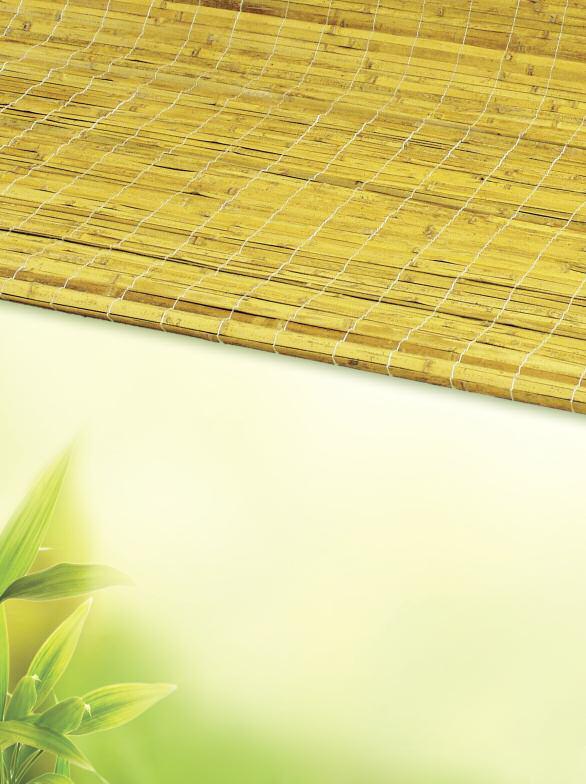
10 • www.OK.org
In addition, while visiting the factory, I had the owner write up a sign, in Chinese, (to be hung up in the factory) stating that the mats being produced now are not for window shades rather they will be used to provide shade for religious purposes To ensure that the sign stated exactly what I requested, I took a copy of the sign and showed it to various Chinese-speaking people, from hotel personnel to airline passengers on the plane ride back from the facility, and asked them to please translate the sign. It was indeed written as I requested.
Mats made in Kenya can be problomatic, as they are used for roofing year round.

The bamboo mats are usually woven or held together by string The string could also present a kashrus problem The string used to tie the bamboo mat should also be made from something that is kosher for schach, so we require 100% cotton string This is because the Shulchan Aruch tells us that a davar hamamid (literally “thing that makes stands,” i e a key element) that is mikabel tumah is not kosher
What does this mean? When laying the schach on the sukkah, you usually lay it on sticks It is not preferable to lay the schach on metal bars This means that the supports for the schach should only be made from something that is kosher for schach l’chatchila (in the first place) however, b’di’eved (after the fact) it is acceptable Similarly, if you were to use something non-kosher to hold together the schach, it would also present a problem Synthetic string is not kosher for schach, hence cotton, which grows from the ground, is preferable
How do we make sure the company is using cotton

string when synthetic string is cheaper and stronger? During production, we send a mashgiach to the factory to make sure that the sign stating the mats are produced for religious purposes is displayed and to check that the string is 100% cotton The mashgiach checks the string by burning it If it is synthetic, the string melts and drips, but if it is cotton, it burns and has a pungent odor like burning hair In addition, when the mats arrive in the United States, we take samples of the string to laboratories, like the Shatnez Laboratory, to make sure that it is 100% cotton One year we found that the company had sent part of the shipment of mats made with string that was not 100% cotton, so we could not, and did not, certify that lot. In addtion, the ~ is the only kosher supervision agency that sends a mashgiach to oversee production every time schach is produced.
Some people question the validity of using string, as there is an opinion that rope is not acceptable for schach, because it may be mekabel tumah. In the Shulchan Aruch HaRav, it is written that a rope is not mekabel tumah. Others, however, are of the opinion that rope can be mekabel tumah because poor girls can use it as jewelry (i e if the rope is braided) Even among those poskim that hold that rope is mekabel tumah, they do not hold that string is in the same category as rope Therefore, this is not pertinent to our situation because the shach is tied with a thin string and is not held together by rope 1
If for some reason one is still not comfortable with using string, Rabbi Moshe Shaul Klein, shlit”a, from the Bais Din of Rav Wosner, shlit”a, suggests putting Xshaped support sticks underneath the mats to ensure that there is absolutely no question since the mats would be functional even if they were not held together by string
The bamboo mats certified by the ~ have enabled thousands of Jews to have easy-to-use, kosher schach for their sukkahs Rabbonim and Jews all over the world use the bamboo mats to cover their sukkahs, in remembrance of the way that Hashem covered the Jews with the Clouds of Glory as they wandered through the desert
www.OK.org • 11
1 See Kovetz Ohr Yisroel, Volume 49, pages 63-67, where this is discussed at length ~
T he bamboo mats cer tif ied by the ~ have enabled thousands of Jews to have easy-to-use, kosher schach f or their sukkahs...

Pome Powerof The
The pomegranate is an ancient fruit native to Iran, but cultivated across the Mediterranean for thousands of years. The word pomegranate derives from the Latin words pomum (apple) and granatus (seeded), owing to its apple like shape and the hundreds of seeds that fill the rind. In Hebrew, the word for pomegranate is rimon, which also means “bell.”
On Rosh Hashanah we eat a new fruit and make the blessing of shehechyanu. Many Jews have the custom to use a pomegranate because of the special symbolisms described here.
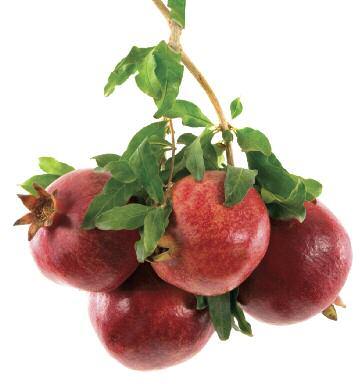
The pomegranate is one of the Sheva Minim (seven species) of plants that Eretz Yisroel was blessed with, and therefore requires the special brocha achrona (grace after meals) for the Sheva Minim. The pomegranate is also a symbol for righteousness, because its 613 seeds correspond to the 613 mitzvos in the Torah Due to its special symbolism, Shlomo HaMelech used the pomegranate as a decorative symbol in the Beis HaMikdash and also had his own pomegranate orchard
In Parshas Tetzaveh, the Torah describes the me’il (robe) of the Kohen Gadol The robe was trimmed with alternating golden bells and pomegranates It is written in the Talmud (Zevachim 88B) that the pomegranates were embroidered with blue, red and purple yarn The trimming on the Kohen Gadol’s robe served to announce his presence as he entered the sanctuary and to atone for the aveirah of Loshon Hara (slanderous speech) Rabbi Moshe Alshich, a venerated rabbi in Eretz Yisroel who lived during the sixteenth century, explained that each measure of speech (bell) was surrounded by two measures of silence (pomegranates), illustrating the importance of thinking before speaking
Elsewhere in the Talmud, in the end of Chagigah, some of the Jewish people are compared to pomegranates. The Talmud explains that the pasuk “Your temple is like a piece of pomegranate...” (Shir HaShirim 4:3) is interpreted to mean “even the empty ones amongst you are full of good deeds as a pomegranate [is full of seeds].” ~
How to Pick and Cut
a Pomegranate
Look f or a large fr uit, with thin, tough, unbroken skin
Use a non-metal knif e to cut the fr uit, as metal can make the juice bitter Cut off the crown of the fr uit and quarter it Soak in water f or five minutes and then separate the seeds under water. T his will allow the seeds to settle at the bottom of the bowl and the sediment to r ise to the top.
Note: The juice of a pomegranate can cause permanent stains
The Healing Power of Pomegranates
Po m e g ra n a t e j u i c e i s k n ow n a s a go o d re m e dy for an upset stomach When the juice or seeds are treated with almond oil, pomegranates can be used to treat chest pain and chronic coughs W h e n d r i e d a n d m i xe d w i t h d r i e d g i n ge r, white cumin and black salt, p o m e g ra n a t e h a s t h e power to increase appetite
Nutr ition Facts
T he pomegranate is known as a “superfruit” f or its high c o n c e n t ra t i o n o f a n t i ox id a n t s . T h e p o m e g ra n a t e c o n t a i n s c a l c i u m , p o t a ssium, iron and phytonutr ients. It may help protect the body against heart disease, d i a b e t e s , r h e u m a t o i d ar thr itis and cancer. Pomeg ra n a t e s c a n a l s o s l ow d ow n t h e a g i n g p ro c e s s , neutralize free radicals and help flush f ats from the digestive tract
Pomegranate Juice
Pure pomegranate juice has all of the nutritional propert i e s o f t h e p o m e g ra n a t e fruit When purchasing bott l e d p o m e g ra n a t e j u i c e, make sure that the juice has a reliable hechsher
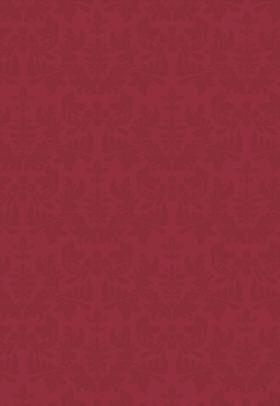
E ve n t h o u g h t h e j u i c e i s p u re, w i t h n o a d d i t ive s , i t may be produced in a f acili t y wh e re o t h e r, p o s s i bly n o n - ko s h e r, p ro d u c t s a re made


www.OK.org • 13
Apples...


 By Rabbi Zushe Yosef Blech
By Rabbi Zushe Yosef Blech
14 • www.OK.org
Like the Breath of
As w e s i t d o w n t o o u r f i r s t m e a l o f t h e y e a r, J e w s throughout the world follow the centuries old cust o m o f d i p p i n g a n a p p l e i n t o h o n e y t o s i g n i f y o u r wish for a sweet year.

Apples have a long-standing place in Jewish life Although the apple was not the Fruit of Knowledge that was Adam’s undoing in the Garden of Eden,1 its mystical connotations in the phrase Sdei Tapuchin are cited by authorities as the basis for dipping this particular fruit in honey at the onset of Rosh Hashanah 2
It is interesting to note that the Hebrew word for apple – tapuach – is not based upon a horticultural root, but rather derives from the concept of something round and inflated, such as when dough rises into a ball or as a name for the round pile of ashes on the Mizbeach (Holy Altar). Indeed, the Imrei Noam argues that our eating of the apple on Rosh Hashanah is an allusion to the pile of ashes of the Akeida Even in the botanical sphere, the word tapuach has been grafted onto many fruits other than the conventional apple Tosefos3 quotes the Targum on the verse from Shir Ha’Shirim that the word “tapuchim” refers to the esrog. [Interestingly, the Targum that we have uses the phrase K’Reicha T’Tapuchin D’Gan Eden – like the fragrance of the “apples” of Gan Eden –perhaps the source of the fable that it was indeed an apple!] The golden apple – tapuach zahav or tapu”z – is the Modern Hebrew word for an orange Similarly, many languages (including Hebrew) have taken the phrase “earth apple” to refer to a po-
tato [pomme de terre (French), erdapfel (German), and tapuach adamah (Hebrew)].

THE POTATO
While the classic apple can be traced back to Shlomo Hamelech, the inclusion of the potato in the European diet began only after its discovery in South America by European explorers Potatoes were originally cultivated in Peru, where they formed an integral part of the diet [They actually did not originate with Sir Francis Drake – he merely brought them to England over fifty years after their discovery by Spanish conquistadors.]
Despite its late start, the potato has managed to gain an astounding ascendancy in our diet. The lowly spud is perhaps the only vegetable that has had the power to effect the depopulation of a country and the derision of an American vice president, and has been adopted by an untold number of countries as its own “French” fries vie with “Belgian” fries to form the nexus of the fast food culture, and no self-respecting simcha would be replete without a potato kugel On Pesach, we press the potato into every conceivable (or inconceivable) service, and whether
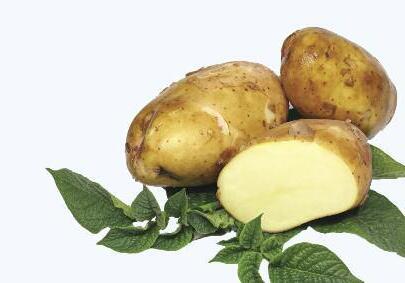
they are called “chips” or “crisps” they follow us everywhere between meals. While the potato itself may be only a humble vegetable, the methods by which it is processed lead to a number of interesting kashrus and halachic issues.
Since potatoes were new to the Old World, their acceptance was far from secure In some areas, ecclesiastical authorities banned the potato as the “Devil’s Apples” because its lack of obvious seeds was deemed unnatural In addition, people worried that potatoes, as a member of the nightshade family, were as poisonous as are many of its cousins (potato plant leaves are indeed toxic, as are potatoes stored until they turn green) Its nutritional advantages, however, overcame such reticence, but not without some high powered royal persuasion In the 1620s, Frederick the Great of Prussia decreed that his subjects plant and eat potatoes as a deterrent to ever present famine, but success was only assured when he threatened to cut off the nose and ears of those who refused. The French, on the other hand, resorted to a high-powered marketing campaign. Antoine Augistin Parmentier, a chemist and friend of King
www.OK.org • 15
Despite its late start, the potato h as m an aged to gain an astounding ascendancy in our diet...
Louis XVI, made it his mission to popularize the potato after surviving as a Prussian prisoner in the Seven Years’ War on a diet of potatoes He prevailed upon the king to serve potatoes at royal feasts, and for Marie Antoinette to adorn her hair with potato flowers His fidelity to the potato was reciprocated with the famous Potage Parmentier (potato leek soup) named in his honor
BROCHA QUESTIONS

The lack of familiarity with the potato may also have played a role in determining its brocha. Most halachic authorities concur that the brocha is ha’adamah, since the potato grows in the ground. The Ropshitzer Rov, however, felt that the appropriate brocha was shehakol, and several rationales are given for this opinion. The Imrei Moshe posits that the Ropshitzer felt that potatoes were more akin to kemehin, those mushrooms that grow underground (truffles), for which a shehakol is indeed said This
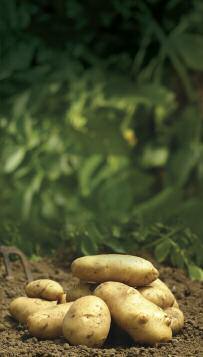
TOP POTATO GROWERS
argument was seemingly buttressed by the observation that potatoes do tend to continue growing “from the air” even after they have been removed from the ground The association between truffles and potatoes is indeed borne out by the use of the name tartuffo in some Italian dialects to mean potato, derived from the Latin terrae tuber or “tuber of the earth” This etymological relationship even carries through to the famous German/Yiddish word kartoffel, which is a corruption of an old German dialect word tartoffel (potato).
The Shinnover Rov, however, rejects this approach and explains the opinion of the Ropshitzer from an entirely different perspective. Chazal recognize that certain foods are particularly satisfying – davar hamayzin – and may serve as the mainstay of a diet even if they are not one of the five major grains The Mechaber, 4 following the opinion of the Rif and the Rambam, rules that we therefore make a mezonos on rice even though it would not be subject to hamotzi or other rules appropriate to true grain Rabbeinu Yonah, quoting the opinion of one of the Geonim, extends this concept to millet and other foods that are particularly satisfying The Shinnover Rov therefore argues that since potatoes exhibit particularly satisfying attributes – they should, by right, also deserve a mezonos according to this opinion As such, in order to avoid a question as to its appropriate brocha, the Ropshitzer advised making a shehakol on potatoes, which is valid for all foods. Many Chassidim follow the minhag of the Ropshitzer – except on Pesach, when they use potatoes for karpas and make a ha’adamah! [This paradox, of course, leads to a new understanding of the Talmud’s explanation for eating karpas – “So that the children will notice something out of ordinary ” When using a potato for karpas, there can be nothing more extraordinary
than reciting a ha’adamah at the Seder when one recites a shehakol the rest of the year!]
BISHUL AKUM
Aside from the appropriate brocha, the manner in which potatoes are processed raises several significant kashrus concerns One such issue relates to the rules of Bishul Akum, the halacha that requires Jewish involvement in the cooking of many types of foods In general, a Jew must participate in the cooking of important foods that are not edible raw – otherwise, such food would be considered non-kosher. The criterion of an important food – something that is oleh al shulchan melachim (literally, served on a royal table) – is somewhat subjective, and depends on the current eating habits in any given locale Given the aforementioned disdain previously accorded potatoes, many authorities5 ruled that they were “peasant food” and therefore not subject to the strictures of Bishul Akum The Chochmas Adam, 6 however, felt that potatoes were indeed an important food and subject to this concern Today, most authorities recognize potatoes to be a food eminently suited for the fanciest of feasts, and have therefore ruled that they indeed are subject to this halachic requirement
Instant mashed potatoes pose an interesting twist to Bishul Akum and potatoes Potato flakes are produced by cooking potatoes, mashing them, mixing them with an emulsifier (an agent that binds oil and water together), and then drying the mashed potatoes by spreading them on the surface of a large, heated steel drum. This thin layer of dried potato is then removed from the drum surface and chopped into flakes, and when mixed with water can be reconstituted into “instant” mashed potatoes. A reliable kosher certification is certainly required due to the use of the
(in million metr ic tons) China 70 Russia 39 India 24 United States 20 Ukraine 19 Germany 10 Poland 9 Belgium 8 Netherlands 7 France 6 World Total 315 Source: UN Food & Agriculture organization 16 • www.OK.org
emulsifier, but what about concerns of Bishul Akum? To address this concern, many hashgachos rely on an opinion of the Avkas Rochel The Avkas Rochel posits that even if a food were rendered non-kosher by din of Bishul Akum, if the food were subsequently rendered “uncooked” – that is, requiring additional cooking – and therefore inedible, it would lose its status as a cooked food as regards the strictures of Bishul Akum Since dry, instant, mashed potatoes are not considered edible and require the addition of hot water to become palatable, it is argued that they fit the parameters of the Avkas Rochel and lose their status of Bishul Akum. This position is questionable, however, in that the re-hydration of the instant potatoes can be done with cold water and thus does not require any additional cooking In addition, merely pouring hot water into a product would, at best, only be iruy (a lesser form of cooking) and not a full-fledged cooking A more cogent rationale for approving potato flakes is that the potatoes are generally cooked with steam and not hot water In general, foods that are smoked are not considered subject to concerns of Bishul Akum, and a number of authorities consider steaming to have the same halachic status as smoking in this regard
Potato chips may be subject to a different leniency as regards Bishul Akum Conventional chips are made by frying thin slices of potato in oil or shortening until they are crisp This food is the quintessential snack, designed to be eaten on the run and, by definition, the antithesis of a stately meal. Many authorities rule that while a particular food may generally be considered important, the manner in which it is prepared must also be taken into account in determining its susceptibility to Bishul Akum As such, the generally accepted approach is to recognize that
chips are not intended to be eaten as part of a meal, and therefore this form of potato would be considered free of concerns of Bishul Akum On the other hand, Rav Yaakov Kaminetzky zt”l is quoted7 as holding that potato chips are indeed subject to concerns of Bishul Akum He, among others, argues that since potatoes as a species are an important food, the fact that potato chips are not important is insufficient to obviate the concern of Bishul Akum The ~ follows this ruling and requires all potato chips to be Bishul Yisroel. Most hashgachos, however, follow the former approach.
While potato chips may not have a concern of Bishul Akum, they are still subject to many other significant kashrus concerns. First, the oil used to produce them must be kosher, and while most companies today use vegetable oil, this is by no means universal In the beginning, all chips are created equal – they are nothing more than simple fried potato As they leave the fryer, however, salt or other flavor powders are sprinkled onto the chip These flavoring pow-
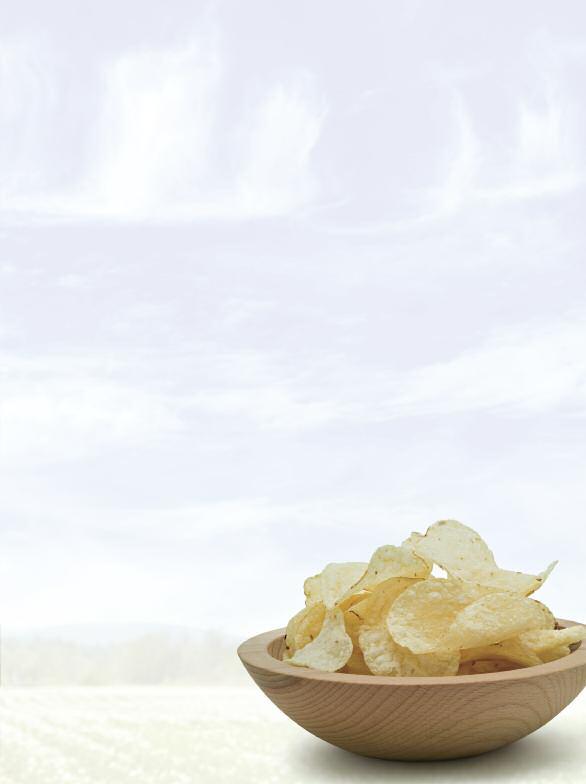
ders contain a number of ingredients, many of which are designed to dilute and disperse the actual spices or flavors Often, lactose (milk sugar) is used in these blends because it does not absorb as much moisture as other sugars and thus does not cake as easily
The method by which these seasonings are applied also raises several kashrus concerns Potato crisp manufacturers generally produce a variety of seasoned products on the same production line, often changing seasonings every few hours. Even where the seasonings are applied at room temperature, it is imperative that equipment used to dispense and apply these seasonings be adequately cleaned between non-kosher and kosher seasonings, as well as between dairy and pareve ones In addition, some companies apply their seasonings as the chips exit the fryer, i e while they are still quite hot In such situations the equipment handling the hot seasoned chips must be kashered between significant seasoning changeovers
The venerable potato crisp had
www.OK.org • 17
The venerable potato crisp h ad ch anged little over the years, with its inn ovations being limited m ainly to the ripple cut and exotic seasonings...
changed little over the years, with its innovations being limited mainly to the ripple cut and exotic seasonings This all changed about thirty years ago with the advent of Pringle-type chips, the trade name of a new kind of potato “chip ” Instead of being made from random-sized slices of fresh potatoes, these chips are created by forcing a potato paste into a uniform shape before they are fried This potato paste is made from potato flour, but this flour, instead of being merely ground potatoes, is actually instant mashed potato flakes (discussed above) that have been milled into a powder As such, the kashrus issues discussed above regarding potato flakes may be of concern In an additional twist, Pringletype chips causes the issue of the appropriate brocha to return to the fore. Most authorities concur that conventional chips are nothing more than pieces of a potato – and hence require a ha’adamah. However, the accepted brocha for ground vegetables is shehakol and, as such, most authorities conclude that the appropriate brocha for Pringle-type chips is shehakol
A recent twist on the crisp has been the introduction of Olean (also known as Olestra), a “synthetic” fat replacement developed by Proctor & Gamble This material can be used to fry chips in much the same way as ordinary oil, but since it passes through the body unchanged it does not contribute any calories to the product Concern has been expressed
about certain health issues regarding this product, but it is indeed kosher certified
The ubiquity of the potato is not limited to the crisp While the French may rue the conquest of the world by American fast food, they may nonetheless take some solace in the fact that one of its mainstays is the French fry (interestingly, it is known as Les Pommes Anglaise in France) Most frozen vegetables pose little kashrus concern, other than the issue of insects However, frozen potatoes – in the form of frozen French fries –differ from conventional frozen vegetables in that they are fried before being frozen Historically, tallow (beef fat) was often used for this purpose due to its lower cost and the flavor that it imparted As such, a reliable kosher certification is critical for frozen French fries to ensure that the factory does not process tallowbased products on the same equipment. Interestingly, this product does not pose a significant issue of Bishul Akum, since the fries are only partially fried in the factory and require additional frying or baking at home to render them edible
While we certainly eat and enjoy potatoes all year long, when it comes to Pesach, potatoes have the distinction of being the only significant domestic source of starch that is considered free from concerns of kitniyos As such, potato starch has become a staple in Pesach cooking and baking, and is used to produce Passover glucose for use in candies
Despite the inherent suitability of these potato products, their processing for Pesach requires extra vigilance Potato starch is often the by-product of other potato processes, and special attention must be paid to the antifoams in the starch slurry and the steam used to peel potatoes to ensure that they pose no kashrus concerns In addition, the emulsifiers used in Pesach potato flakes must similarly be approved for Pesach Even simple peeled, fresh potatoes (and some other pre-peeled fruits and vegetables) are not immune to Pesach concerns, since companies that peel fresh potatoes often wash the peeled product with citric acid and other chemicals to prevent the potatoes from changing color.
As we have seen, the potato has become quite pervasive in our culture in the 400 years since it was introduced to the Western world Even on Rosh Hashanah, when we dip our “apple” in honey this year, the lowly potato may indeed have greater relevance than one might think The Eliyahu Rabbah8 and the Gilyon Rav Akiva Eiger9 quote the custom of the Mahari”l to eat “erd appel” on the first night of Rosh Hashanah, at which time he made a shehechiyanu on the new “fruit” While the appropriateness of making a shehechiyanu on a potato may not be universally accepted,10 it may nevertheless be well to remember this other tapuach and the beneficence with which Hashem has granted us both enjoyment and sustenance over the years ~
1 Sanhedrin 70b
2 Taz O C 583:2
3 Shabbos 88a
4 O C 208:7

5 E g , Aruch Ha’Shulchan 113:18
6 Chochmas Adam 66:4
7 Emes L’Yaakov 113:9, footnote 42
8 Eliyahu Rabbah 583:2
9 O C 225
10 Mishnah Berurah 225:18
18 • www.OK.org
The potato h as become quite pervasive in our culture in the 400 years since it was introduced to the Western world... it indeed h as greater relevance th an one might think.
Who will be r ich and who will be poor?
- Yom Kippur liturgy
Tips to protect yourself from
5 CREDIT & IDENTITY THEFT
Anew year is upon us and we must take the time to examine all aspects of our lives, both spir itually and physically. Make sure that this year you will have no regrets about the secur ity of the items in your wallet...
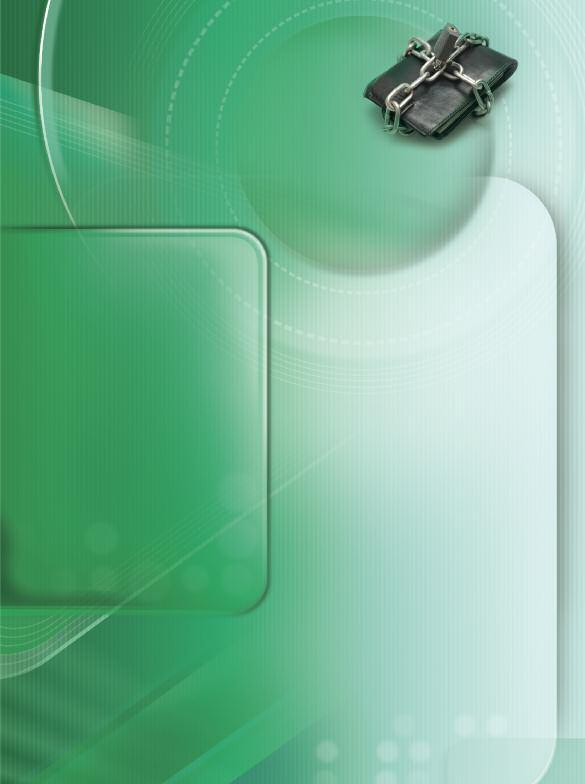
Today’s f ast-paced world of electronic convenience has made identity theft an ever-increasing problem. You probably know someone who this has happened to it may have even happened to you Identity theft can be a nightmare and an expensive and time consuming one at that. Here are simple actions you can take that can help to protect your identity and your credit rating.
Kosher Identity Theft: Did you know that the ~ has a special depar tment to track and handle unauthor ized products


1
When you order checks, don’t use your full first or middle names; use your initials with your full last name instead. Who’s going to guess that “B” stands f or “Baila” or “Bor uch” when attempting to f orge your signature?
2 Instead of using your home phone number on your checks, put your work number. In addition, if you have a PO Box, use it f or your address and never, ever publish your Social Secur ity number on your checks.
3 Make photocopies of ever y piece of identification that you car r y with you daily and be sure to copy both sides Keep the copies in a saf e and handy place If your wallet is ever stolen, all the inf ormation you’ll need: auto license and registration, credit card account numbers, and customer ser vice hotlines, will be available to you in one place.
4
If your credit cards are stolen, immediately file a police repor t in the jur isdiction where the theft occur red You’ll want as much documentation as possible to prove to your credit card issuers that you were diligent
5
If your credit cards are stolen, call all national credit repor ting organizations immediately to place a fraud aler t on your name and Social Secur ity number T he aler t lets any company that checks your credit to know that your inf ormation was stolen and that they are to contact you by phone to author ize any new credit T heir numbers are: Equifax 800-685-1111, Exper ian 888-397-3742, and Trans Union 800-888-4213 In case your Social Secur ity card or number is stolen, it may be best f or you to notify the Social Secur ity Administration 800269-0271, too
While no amount of caution can be totally f ool-proof , being aware of the potential identity theft possibilities and how to protect ourselves, even if we f all victim, are simple steps to give us an added def ense ~
www.OK.org • 19
hn hbgh hn ragh This article appears courtesy of Abraham Fried Abraham is a Registered Representative offering securities through MetLife Securities, Inc (MSI) (member FINRA/SIPC), New York, NY 10166 Insurance and annuities offered through Metropolitan Life Insurance Company (MLIC), New York, NY 10166 MSI and MLIC are MetLife companies He focuses on meeting the individual insurance and financial services needs of people in the heimishe community You can reach Abraham at his office at 15 Bay Ridge Avenue, Brooklyn, NY 11220; 718-567-3139 and at
abefried com L12071392[exp1208][All
www
States][DC]
T i s h r e i R e c i p e s

Melons & Ber r ies in Wine
1-1/2 cups white wine
2 tablespoons honey or sugar
2 or 3 slices ginger
1/2 medium cantaloupe, seeded
1/2 honeydew, seeded
1/2 Casaba or Crenshaw melon, seeded
2 cups frozen strawberries* (with a reliable hechsher)

1 to 2 cups fresh blueberries
In a saucepan, combine wine with honey and ginger Bring to a boil; reduce heat and simmer, uncovered, for 5 minutes Remove from heat and let cool to room temperature Discard ginger Use a melon baller to scoop out balls from the melons Place in a large bowl along with the strawberries and blueberries Pour the cooled wine over fruit and mix gently Refrigerate for 1 to 2 hours to blend the flavors Spoon fruit into chilled serving dishes Drizzle wine over fruit
Yield: 8 servings
* If you would like to use fresh strawberries, please see our washing instructions on the next page
20 • www.OK.org
Strawber r y
WASHING INSTRUCTIONS
1. Cut off green stems and leaves.
2. Wash, soak and rub each strawberry in soap or veggie wash solution for 3 minutes (Maximum 25 strawberries at a time )

3. Dump out the water, rinse the strawberries.
4. Wash, soak and rub the strawberries once more for 3 minutes.
5. Rinse the strawberries, eat and enjoy.
Please note:
Strawberries with holes should not be used
Low-Fat Apple Cake
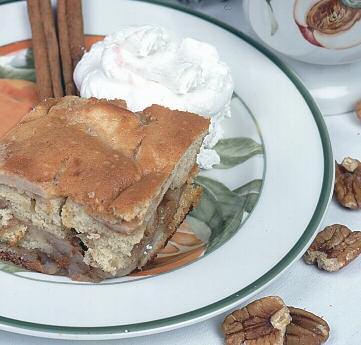
2 whole eggs (or 1 whole egg plus 2 egg whites)
1 cup sugar
1 teaspoon vanilla


½ cup unsweetened applesauce
2 tablespoons water
1½ cups flour (you can use half whole wheat)
2 teaspoons baking powder
½ teaspoon cinnamon
6 apples, peeled, thinly sliced
¼ cup brown sugar, firmly packed
Beat eggs, sugar, and vanilla, until light Add applesauce and mix well Add water, flour, baking powder, and 1/2 teaspoon cinnamon Mix just until flour disappears In another bowl, mix apples with brown sugar and cinnamon. Spray a 7”x11” Pyrex pan with non-stick spray Spread half of batter in pan Spread apples evenly over batter Top with remaining batter and spread evenly (If you wet your spatula, the batter will be easier to spread ) Bake at 350°F for 45 to 55 minutes, until golden brown
If frozen, cake will become more moist Just reheat it for 10 minutes at 350°F
Yield: 12 servings
www.OK.org • 21
Pop-Up Sukkah
By Rabbi Chaim Fogelman
s a child, I remember hearing a s t o r y a b o u t a r a b b i w h o had to build a sukkah.
it doesn’t take a great deal of wood to ttle sukkah, it does require some wood, d effort After rummaging through all the wood he could find and putting in hours the rabbi finally put his little sukkah to- one piece of wood here and one piece ere Every halachic loophole was used to make it a kosher sukkah The gaps between each board were not bigger then three hand-breadths, some boards did not extend all the way up to the schach, and so on. But when all was said and done, the rabbi had a kosher sukkah. He brought in a table and chairs, put his silver kiddush cup on the table along with his wife’s silver candlesticks, and put a lock on the door and went to sleep The next morning, when he unlocked the sukkah, he was shocked to see that someone had stolen the kiddush cup and candlesticks “How can this be?” he wondered The halacha dictates that a sukkah is considered to have a solid wall if the spaces are no bigger than three handbreadths So how did the thief get in? The rabbi concluded that obviously the thief did not know the laws of building a sukkah!
Today it is rare to find a sukkah made from wooden planks, with gaping spaces between them A drive through any Jewish neighborhood will showcase very interesting and creative sukkahs, but the most ingenious sukkah design is the instant, portable, pop-up sukkah
How did the idea for a popup sukkah come about? What were the halachic challenges? And how does it work?

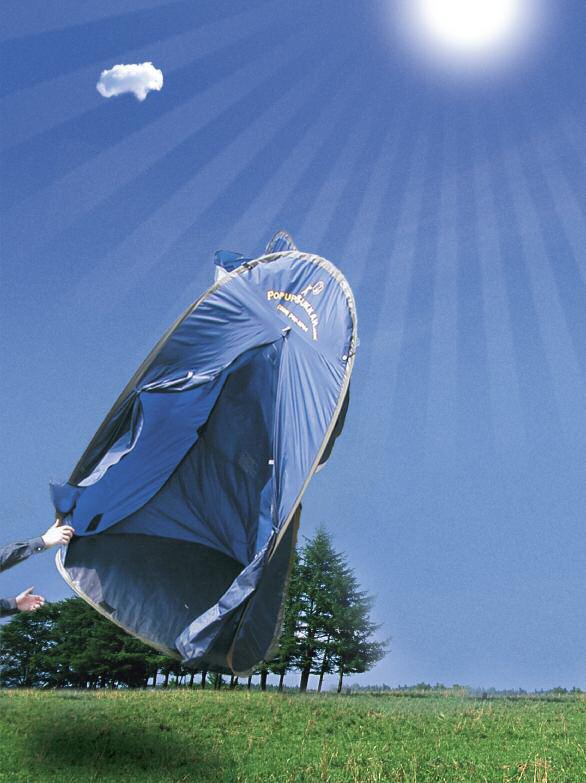
22 • www.OK.org
Size


First the sukkah needs to be sized just right – portable but halachically correct. The minimum size for a sukkah is seven tefachim (handbreadths) wide by seven tefachim deep and ten tefachim high (26 46” wide x 26 46” deep x 37 8” high) Though this sukkah would be a truly portable sukkah that could literally be taken anywhere, it could not be smaller than 7x7x10 Therefore, the pop-up sukkah was made to be 42 inches square and over 6 feet tall, to avoid any halachic questions on its size
Stabilty
A sukkah must be able to withstand a normal windy situation If a sukkah were to blow over from a regular wind it would render the sukkah not kosher The pop-up sukkah is made out of a thin, waterproof, tent-like material and weighs only seven pounds To combat the halachic problem of its weight and stability, two long velcro straps were sewn into the sukkah When one
sets up the sukkah, one must tie the straps to something solid, like a car handle or a parking meter. Tying the sukkah to a tree could cause other problems, like having the tree branches hovering above the sukkah, which would render the sukkah unfit because a sukkah must be directly under the sky

In addition to the requirement of withstanding a normal wind, the sukkah cannot move or sway Walls that wave to and fro pose questions regarding the structural integrity of the sukkah To solve this problem, tension rods that snap together cause the material to stretch tightly from corner to corner and special cross-ties were installed to make the sukkah structure stiff
Schach
The Shulchan Oruch states that, optimally, the schach of a sukkah should not rest upon something that is susceptible to tumah (ritual impurity), i e metal or any utensil used to hold liquid There-
fore, two plain bamboo sticks are included to hold the schach.
For more information regarding the way the ~ gives a hechsher for the production of bamboo mats for the schach, see Rabbi Levy’s article on page 10.
With its zippered door and windows, the pop-up sukkah offers no compromise in kashrus, privacy, and portability It is noteworthy to mention that although the pop-up sukkah is a kosher sukkah, one cannot always recite the brocha of “leishev b’sukkah” in it Making the brocha depends on where one has set up the sukkah If the sukkah is on private property and you have permission to erect it there, one can make the brocha However, if the sukkah is built on public property it is halachically questionable if the brocha can be made This rule does not only apply to the pop-up sukkah, but to any type of sukkah erected on public property ~
A f ew words from the inventor, Shmuli Sufr in… How did you come up with the idea for a Pop-Up Sukkah?
In 1992, I was flying back to London after Pesach Looking through the Skymall magazine, I noticed a pop-up tent Immediately I thought, “If I could create a pop-up sukkah that could be set up in seconds, how many more people would keep the mitzvah of sukkah!” After many prototypes, I finally got what I thought was the perf ect product I took the sukkah to the ~ and thought they would say, “It’s perf ect!” Boy was I wrong It had many halachic issues I met with Rabbi Chaim Fogelman and other rabbis from the ~ and over the next year spent many hours on the roof top of the ~, each visit with a new prototype from the f actor y, until finally I heard the words I was waiting f or: “Mazal tov, the sukkah is now kosher ” To date we have sold close to 10,000 sukkahs worldwide and I know all the eff or t paid off when I hear the stor ies about where the pop-up sukkah has been used: at hospitals, atop skyscrapers, in the Iraq war, and many other unimaginable places Although there are some other “por table sukkahs” the pop-up sukkah is the f astest to set up and one of the f ew with a hechsher. ~ Kosher, I couldn’t have done it without you.
Simple two-step setup
www.OK.org • 23
WHO’S BEHIND THE ~
BEHIND
KS:Where did you grow up?
RCC: I grew up in Denver, Colorado and learned in Yeshivas Toras Chaim in Denver, Beis Medrash Gevoha in Lakewood, and Stichting Chacham Tzvi in Amsterdam
KS:What did you do after yeshiva?
RCC: After yeshiva, I married my wife Chana Devorah in 1982 We moved to Chicago where I worked as a rebbe and dorm rebbe in Skokie Yeshiva

KS:When did you get involved in hashgacha work?
RCC: I first started working in hashgacha in 1993.
KS:When did you star t working f or the ~?
RCC: I started working for the ~ in February 2000 and my responsibilities included ingredient and formula evaluation, as well as overseeing facilities that produced flavors and chemicals
KS:What is your cur rent position at the ~?
RCC: I am the Rabbinical Coordinator for European, African and Asian Accounts I oversee most of the ~ certified companies in these areas, except companies in Israel and China, and schedule and oversee their annual visits.

KS:What prepared you the most f or working at the ~?
RCC: Before working at the ~, I spent seven years assigned to specific flavor production facilities There I learned the operational process and got hands-on experience with the specialized production equipment Those seven years of experience enabled me to have a high-level of knowledge of the technical aspects of flavor production, which greatly enhanced my knowledge of the halachic aspects
KS:What is best thing about working at the ~?
RCC: The best thing about working at the ~ is the people that I work with We have a staff that has expertise in many different areas and they are always willing to share their expertise and work together to provide the best service to its clients
KS: How would you descr ibe the ~ today?

RCC: The ~ works with its customers to make sure that their kosher program works for them, while upholding the highest standards of kashrus. The ~ expends great effort making sure that there can be no possible questions about the validity of its supervision and takes great care to protect its customers and the public from kashrus errors.
KS: Can you share a unique exper ience that you had while working at the ~?

RCC: I once had an argument with a plant engineer concerning whether or not stainless steel can absorb or not. He maintained and brought extensive documentation to prove that stainless steel can’t absorb anything and therefore should not need kosherization. I told him, your proofs are impressive but the Rabbis decreed 2000 years ago that metal needs kosherization and I do not have the authority to go against them. We agreed to differ.
Approximately a year later, I was in the process of
~
Interview with Rabbi Chaim Cohn
M E E T O U R S T A F F : 24 • www.OK.org
Rabbi Chaim Cohn
supervising the kosherization of a 1000 gallon reactor and after the workers had meticulously cleaned it we brought it to a boil There was about a quarter of an inch of scum on the top of the pot The engineer was passing by and I called him over to look at it I said, “This was a completely clean pot ” I turned to the workers and asked, “Right?” The workers nodded their heads vigorously up and down. The engineer looked at it and said, “ I can’t argue with empirical evidence,” and walked away.
Six months later I got a call from the engineer He said, “Rabbi Cohn, I now understand ” “Great,” I thought, and asked, “You now understand what?” He answered, “I understand why a stainless steel vessel will absorb ” I asked, “Why?” He answered, “You have to understand, when it leaves the factory it can’t absorb anything, however, when it is heated it expands and contracts and it will produce micro fissures Your Rabbis were right, you can’t measure this and therefore have to assume the worst-case scenario that the entire volume has absorptions in it.”
“What Other People Say About Rabbi Chaim Cohn



Rabbi Chaim Cohn has a great range and depth of experience in complicated facilities such as flavor houses, contr ibutes much to the kashr us industry, and fits in nicely with our experts He has also been heavily involved in helping set up our receiving system in certified facilities to ensure the highest levels of compliance with our kosher standards.
Rabbi Don Yoel Levy, Kashr us Administrator, ~ Kosher Certification
Naturex has been working closely with Rabbi Cohn for several years on our kosher certification. Rabbi Cohn now coordinates the certification program for our 4 facilities (and one ongoing). He sets all kosher procedures, ensuring that the kosher processes from raw materials to final products are run properly We appre- ciate working with Rabbi Cohn as he always takes the time to understand our production system and guides us in order to meet kosher requirements. On a daily basis, Rabbi Cohn always make himself available and helpful, which is very important for us in our fast-paced business.
Marc Detcheverry, Product Development Manager, Naturex
AsRabbi Cohn’s colleague and carpoolmate for many years, I can attest to the fact that his dedication to the ~ does not end when he leaves the office. His background in chinuch is clearly displayed as he guides mashgichim worldwide through the intr icacies of hashgacha from his mobile phone In addition to his constant devotion to kashr us, he continues to deliver many shiur im, as well as leading a boy’s mishnayos group, which has finished “Shisha Sidrei Mishna” numerous times. It is an honor and a privilege to work alongside a man with such an unyielding commitment and vast knowledge who contr ibutes to the ~’s goal of maintaining the highest kosher standards.
Rabbi Yitzchak
Gornish, Rabbinic Coordinator, ~ Kosher Certification



“Rabbi Cohn always takes the time to understand our production system and guides us in order to meet kosher requirements”
– Marc Detcheverry, Product Development Manager, Naturex
“www.OK.org • 25
During the time of the Beis HaMikdash, nisuch hamayim (pouring of the water) was an important part of Sukkos. During the year, the daily korbonos (offerings) on the altar were accompanied by a wine offering, but on Sukkos, water was offered in addition to wine. This water was drawn early in the morning from the Shiloach Spring, which flowed near the Beis HaMikdash The entire previous night was devoted to celebrations in the courtyard of the Beis HaMikdash The Levi’im (Levites) played music, people juggled lit torches and sang and danced throughout the night The Gemara speaks of the great joy at Simchas Beis HaShoeva, saying: “One who did not see the joy of the water-drawing celebrations, has not seen joy in his life ”
Simchas BEIS H A SHOEVA
simple mitzvah done with kabbalas ol has more value to the person than the deepest secrets of Torah. Sukkos, which comes after Rosh Hashanah and Yom Kippur, two holidays which focus on kabbalas ol, is a time when we are most open to experiencing the fulfillment that comes from the seemingly ordinary act of kabbalas ol.
Chassidic Insights
Compiled by Dina Fraenkel
Water and wine also represent two types of joy – unlimited spiritual joy and limited physical joy Wine, by nature, leads to physical joy due to its intoxicating properties Since the joy associated with wine has a physical basis, it is bound by the limitations of nature Therefore, when wine is offered on the altar, the spiritual joy of the offering is mixed with, and limited by, a physical joy
Why was water offered, in addition to wine, as part of the korbonos of Sukkos? According to the Kabbalah and Chassidus, water and wine represent two different aspects of our service of Hashem. Water, which is tasteless and colorless, but at the same time the essence of life, represents kabbalas ol malchus shamayim (the acceptance of the yoke of Heaven), which is the basis of Torah and mitzvos – recognizing Hashem as our Master and committing ourselves to observing His mitzvos. Wine, on the other hand, which is sensually gratifying, represents the emotional and spiritual aspect of our service of Hashem It signifies the joy we experience while observing Torah and mitzvos
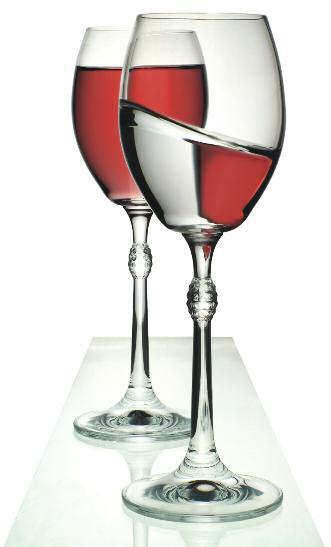
So why is water, which is tasteless and colorless, used to symbolize our great joy – a joy unequaled by any other experience – on Sukkos? Water, has no taste and only requires a brocha when one drinks it out of thirst Imagine for a moment that you have just come inside after a long walk on a hot summer day You are parched and aching for a drink of water When the cold water hits your mouth, at that moment, it is tastier than a glass of wine! The same is true in a spiritual sense When one has a thirst for a connection to Hashem, a
In contrast, tasteless, colorless water does not, by its nature, bring one to a state of joy Therefore, the joy associated with the water offering was completely spiritual, because it was offered based on Hashem’s command to “draw water with joy.”
Since Hashem and His mitzvos are not limited by nature, the joy associated with the water offering has no limits. When one serves Hashem through study and contemplation, this represents the wine offering, since it is limited by the intellectual capacity of the person, while the water offering is compared to serving Hashem with self-sacrificing kabbalas ol, of which every person is capable
The joy of Sukkos, Z’man Simchaseinu, comes from the great spiritual achievements of Rosh Hashanah and Yom Kippur –the days we strove to bind ourselves with the Essence of Hashem, to serve Hashem like water with self-sacrifice and kabbalas ol The connection is finally revealed during Simchas Beis HaShoeva and nisuch hamayim – the joy that comes from fulfilling Hashem’s mitzvos and binding ourselves to Him, which transcends all limitations
26 • www.OK.org
Shaimos... Holy Schach
The Chasam Sofer did not accept a student into the yeshiva in Preshburg, because he noticed that the young man stepped on some schach that was on the floor after Sukkos and that showed him that the young man lacked yiras shomayim
Shmitta/Agr iculture...
Amazing Little Country
Date palms have grown in the Middle East for centuries The average tree is about 18-20 feet tall and yields about 38 pounds of dates per year However today, an averge date tree in Israel yields 400 pounds of dates per year and is short enough to be harvested from the ground or by using a short ladder!
Nisuch HaMayim...
Wonderful Water
• Roughly 70 percent of an adult’s body is made up of water
• There is no scientific evidence that people should drink 8 glasses of water a day While it’s important to stay hydrated, nearly every food or drink item provides some water to the body
• The total amount of water on the earth is about 326 million cubic miles of water
• The United States uses about 346,000 million gallons of fresh water every day
On the Esrog...
Why does an esrog need to be absolutely complete?


Let’s Talk Honey...
• Honeybees are disappear ing at an alarming rate and exper ts still cannot figure out why! T his problem, named Colony Collapse Disorder, has aff ected over 60-70% of bee colonies in the U S
• Honeybees fly 50,000 miles to collect enough nectar f or one pound of honey.

• Bees navigate by using the sun as a compass
• Honeybees annually pollinate over $14 billion wor th of seeds and crops (1/3 of our countr y’s f ood supply)!
• Honeybees produce 4 things: honey (kosher), royal jelly (accepted as not kosher), beeswax (kosher) and bee propolis (kosher)
• W hy do we dip apples in “honey” on Rosh Hashanah? שבד (Dvash – honey) has the same numer ical value as ןמחרה בא (Av Harachamon –Merciful Father) = 306
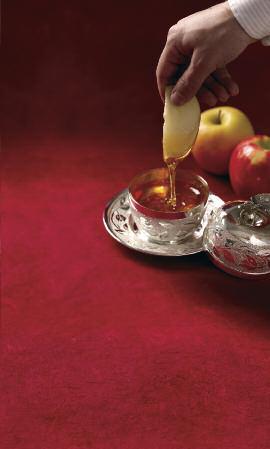
• Many leading rabbis would bless each other and their congregations with a sweet new year, because just like sweet honey is obviously good to all (even to small children), so too, all that happens to us next year should be clearly and openly good.
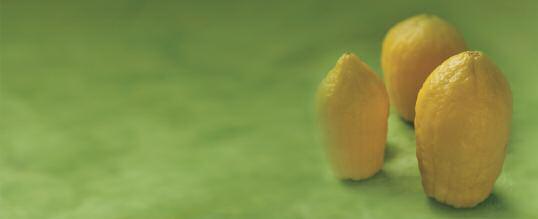
PLEASE NOTE: Doctors recommend that children under 12 months of age should NOT be f ed honey
Esrog (גרתא) is an acronym for four things that always need to be complete – the first two are things that a person has to give to Hashem:
המילש הנומ א (Emunah Shleimah) – Complete Faith, and המילש הבושת (Teshuvah Shleimah) – Complete Repentance
And in return, Hashem gives:
המילש האופר (Refuah Shleimah) – Complete Healing, and המילש הלוא ג (Geulah Shleimah) – Complete Redemption
It is important to be humble about the quality and hiddur of your esrog.
Esrog (גרתא) is also an acronym for: הואג לגר ינאיבת לע (Al t’vi’eni regel gaiva) – One should not boast about his esrog
O D D S & E N D S www.OK.org • 27
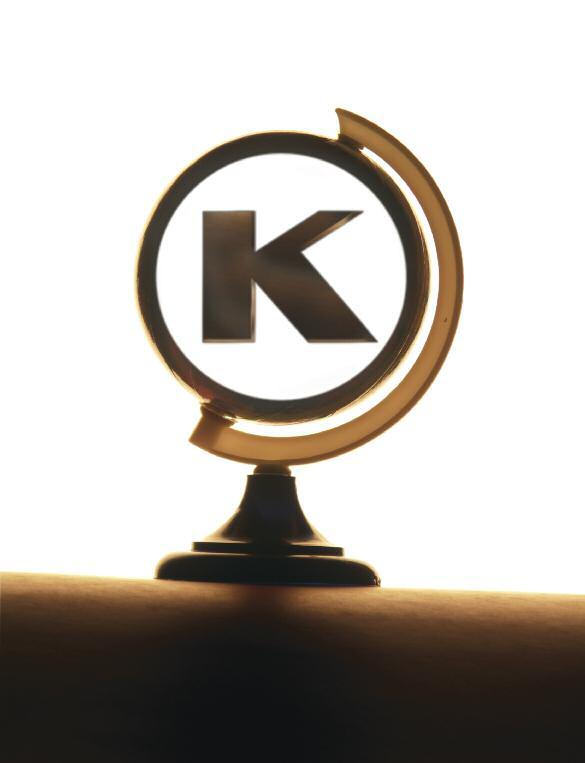
Kosher Without Compromise. KOSHER CERTIFICATION ~ Kosher Spir it, 391 Troy Ave., Brooklyn, NY 11213 718-756-7500 • inf o@ok org • www ok org









 By Rabbi Yosef D. Chanowitz
By Rabbi Yosef D. Chanowitz















 By Rabbi Zushe Yosef Blech
By Rabbi Zushe Yosef Blech

































